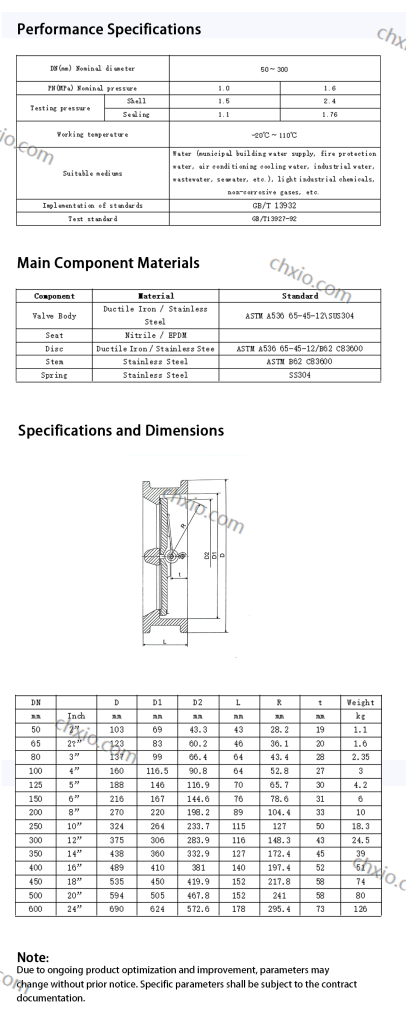Wafer Butterfly Check Valve



Product Features and Applications
Structural Features
Wafer Connection:
Uses a wafer connection method, with the valve sandwiched between two pipeline flanges and secured with bolts. This allows for quick installation without the need for special flanges or fittings, making it suitable for space-constrained piping systems.
Butterfly Disc:
The disc inside the valve is butterfly-shaped and controls the opening and closing of the valve through axial rotation. When the medium flows in the forward direction, the disc is pushed open, allowing the medium to pass through; when the medium flows backward, the disc automatically closes to prevent backflow.
Valve Body Material:
The valve body is typically made of cast iron, ductile iron, stainless steel, or carbon steel, providing good corrosion resistance and mechanical strength, suitable for different media and working environments.
Sealing Structure:
The valve employs either a soft sealing or hard sealing structure, with suitable sealing materials such as EPDM, NBR, or metal seals selected based on working conditions to ensure that the medium does not leak during backflow.
Compact Structure:
The overall design is simple and compact, lightweight, and does not occupy excessive space during installation, making it particularly suitable for piping systems with limited installation space.
Performance Features
Preventing Backflow:
When there is a tendency for backflow in the pipeline, the butterfly disc will close rapidly to prevent the medium from flowing backward, protecting the pipeline and equipment, and avoiding failures or accidents caused by backflow.
Easy Installation:
The wafer connection method allows for very convenient installation and removal of the valve, requiring no special tools or complex operations, which reduces installation time and maintenance costs.
Low Flow Resistance:
When opened, the butterfly disc provides a large flow area, reducing flow resistance and ensuring smooth medium flow, thereby improving the operational efficiency of the system.
Good Sealing Performance:
With appropriate sealing structures and materials, the valve can close quickly during backflow and provide reliable sealing to prevent leakage.
Wide Applicability:
This valve is suitable for various liquid and gas media, capable of stable operation in environments with low temperature and normal pressure or high temperature and high pressure, demonstrating strong adaptability.
Application Fields
Industrial Pipeline Systems:
Widely used in industries such as oil, chemical, metallurgy, and power generation to prevent backflow of media, protecting equipment and pipelines.
Water Supply and Drainage Systems:
Employed in municipal water supply and wastewater treatment systems to prevent backflow, ensuring the normal operation of the system.
HVAC Systems:
Utilized in HVAC systems to control the flow of cooling water and chilled water, preventing backflow that could lead to system malfunctions.
Fire Protection Systems:
In fire protection pipelines, it prevents water from flowing back into the main water supply system, ensuring the reliability and safety of the fire protection system.
Installation and Maintenance
Select the Correct Valve:
Select the Correct Valve:
- Ensure the wafer-style check valve matches the pipeline’s pressure, temperature, and media requirements.
Preparation:
- Before installation, inspect the valve for any damage or defects.
- Clean the interior of the pipeline to remove debris and ensure a smooth surface to prevent damage to the valve sealing surfaces.
Installation Position:
- Typically, the wafer-style check valve should be installed in horizontal pipelines to minimize gravity-induced issues.
- Ensure the valve’s installation direction is correct; there is usually an arrow on the valve indicating the flow direction.
Pipe Connection:
- Use appropriate tools and methods to connect the pipeline, ensuring the valve’s flange is flush with the pipeline flange.
- During installation, avoid applying excessive pressure or stress on the valve to prevent damage.
Bolt Tightening:
- When installing the wafer-style check valve, bolts should be tightened evenly to avoid localized over-tightening or loosening.
- Avoid using excessive torque, which could damage the flange or valve body.
Check for Leaks:
- After installation, perform a pressure test to check for any leakage from the valve.
- If leaks are found, recheck the installation and make necessary adjustments.
Maintenance
Regular Inspection:
- Periodically check the valve’s appearance and operational status, especially in high-frequency usage situations.
- Look for visible damage, corrosion, or wear on the valve.
Cleaning:
- Regularly clean the valve and its surrounding area to prevent dust, dirt, or other debris from affecting its operation.
- Use appropriate cleaning agents and tools to avoid damaging the valve surface.
Lubrication:
- If the valve’s sealing components or moving parts require lubrication, use the proper lubricant for routine maintenance.
- Avoid using unsuitable lubricants that could negatively impact sealing performance.
Seal Inspection and Replacement:
- Regularly inspect the condition of sealing components to ensure they are not worn or damaged.
- Replace seals promptly if issues are found to maintain the valve’s sealing performance.
Function Testing:
- Periodically test the valve’s functionality to ensure it operates correctly to prevent media backflow.
- Check that the valve opens and closes smoothly without any sticking issues.
Record and Track:
- Keep records of maintenance and repairs to monitor the valve’s performance and anticipate potential issues.
Proper installation and regular maintenance of a wafer-style check valve ensure effective backflow prevention, extend its service life, and maintain the normal operation of the pipeline system.